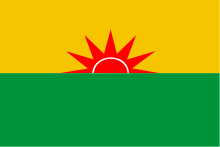United Liberation Front of Asom
The United Liberation Front of Asom ( ULFA ) is a group that uses terrorist means to fight for an independent, socialist Assam and is thus involved in the Assam conflict . It is considered to be the strongest separatist organization in northeast India .
It was founded on April 7, 1979 in the historic Rang Ghar Pavilion in Sivasagar . The chairman is Arabinda Rajchowa, his deputy is Pradip Gogoi. Until December 2003 they resided in the forests near the Indian-Bhutanese border. However, military operations by the Indian army prompted the leadership to evade to Bangladesh .
Since the early 1990s, the ULFA has concentrated on attacks and assassinations: It ambushed Indian security forces, blew up railroad connections and oil pipelines and killed political opponents. In July 1991, the UFLA kidnapped 14 people, including a Russian engineer, and demanded a ransom, but then killed the hostages. In 1997 she kidnapped and murdered Sanjay Ghose, an Indian social activist. On August 15, 2004, a ULFA bomb killed 10 to 15 people in Assam, including school children.
The military wing of the ULFA, the Sanjukta Mukti Fouj (SMF), was founded on March 16, 1996. Its commanding officer is Paresh Barua . He is subordinate to three well-trained battalions: the 7th, 28th and 709th. Another four battalions exist on paper. The Indian army counts around 3,000 fighters in the ULFA. According to other sources, there are between 4,000 and 6,000 fellow campaigners. Training camps existed in Bhutan and Bangladesh. In late 2009 there was a massive operation by the Indian military against separatist rebel groups from the northeast. Almost the entire leadership around the "chairman" Arabinda Rajkhowa was arrested on Bangladeshi territory and extradited to the Indians.
The ULFA is financed by blackmailing business people, bank robberies and drug smuggling . In addition, she runs various medium-sized companies in Bangladesh.
attacks
- June 28, 1988: Bomb attack on a theater in Assam, 7 dead and 60 injured
- July 10, 1988: Attack on a cinema in Nagaon , injuring 50 people
- November 6, 2006: Double attack in Guwahati , 15 dead and 50 injured
- January 5, 2007: Series of attacks against guest workers, 48 dead and 19 injured
- June 13, 2007: Bomb attack on a vegetable market in Assam, one dead and 40 injured
- November 23, 2014: Bomb attack on a market in Rajgarh , 2 dead and 26 injured
See also
Individual evidence
- ↑ Subir Bhaumik: Shortly before rear India. In: Le Monde diplomatique, German edition. February 12, 2010, accessed on September 23, 2011 (from, the, English, by, niels, kadritzke).
- ^ Entry in the Global Terrorism Database. University of Maryland. Retrieved February 20, 2019.
Web links
- ULFA website ( Memento of November 4, 2007 in the Internet Archive ) (English)
- ULFA portrait on the South Asia Terrorism Portal website
- Bobby Sarangthem: United Liberation Front of Asom (English)

